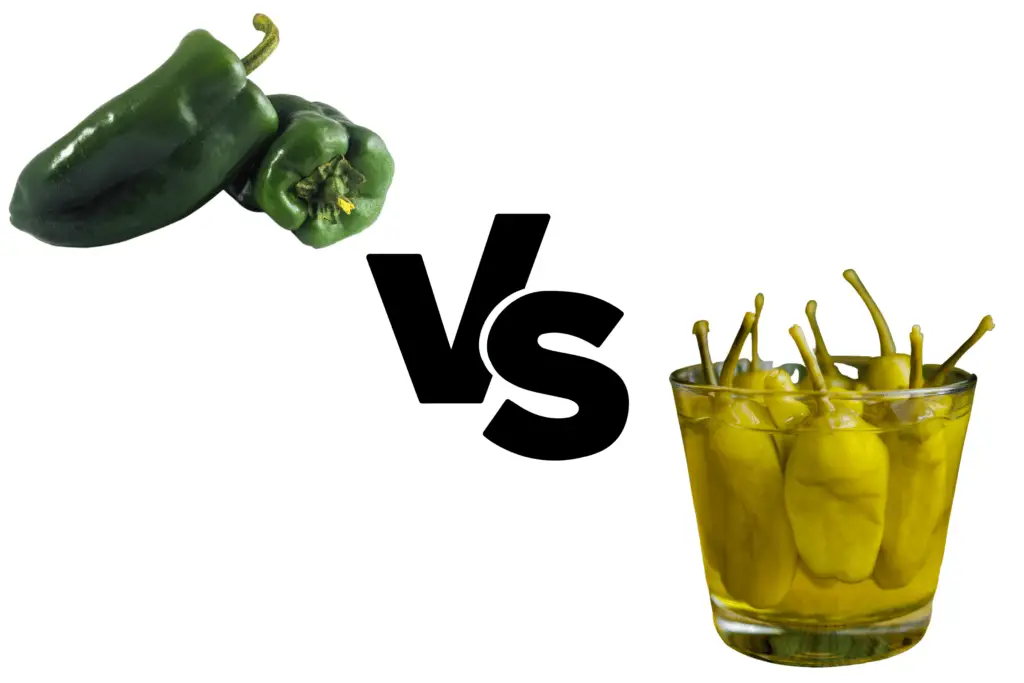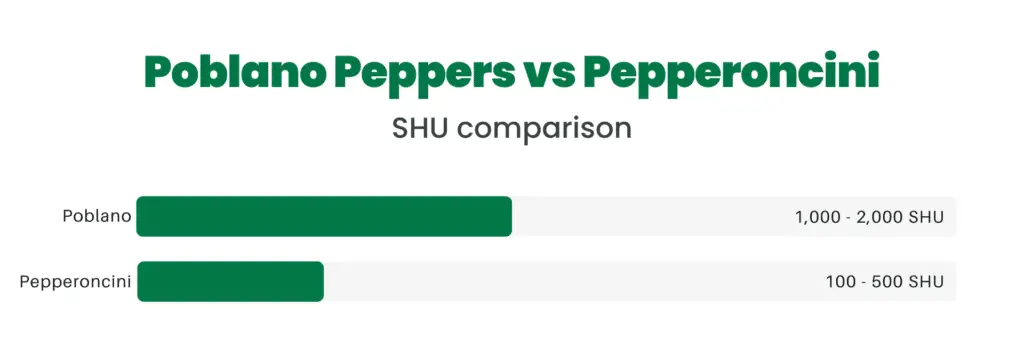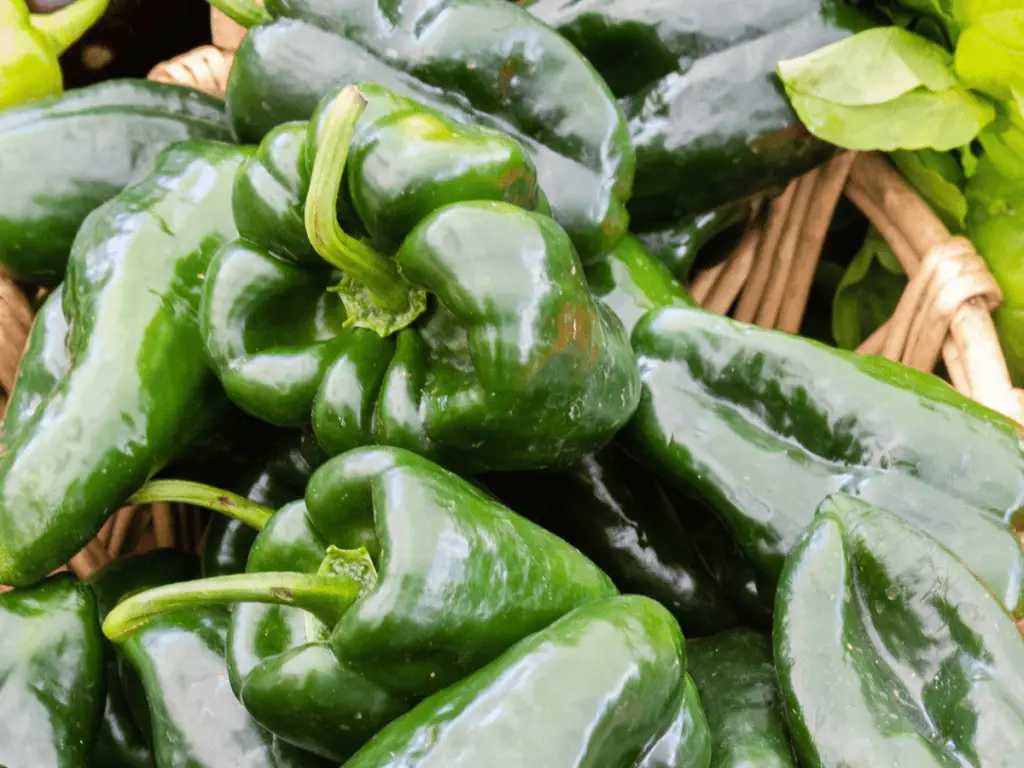Pepperoncinis are everyone’s favorite part of antipasto! But how do they hold up against the mighty poblano?
Pepperoncini peppers have an SHU rating of 100-500 SHU while poblanos are typically 1,000-2,000. Pepperoncini peppers are small, slightly wrinkly peppers that have a tangy test, making them a popular choice for pickling. Poblanos are double the size of pepperoncinis and have an earthy taste.
Read on for an in-depth comparison between poblano peppers and pepperoncini peppers!
Comparison – Differences between poblano peppers and pepperoncini peppers
Poblano and pepperoncini peppers are both relatively mild, but they have very different culinary uses.

Let’s look at the similarities and differences between poblano and pepperoncini peppers based on the following criteria:
- Poblano peppers vs pepperoncini peppers heat level
- Poblano peppers vs pepperoncini peppers flavor
- Poblano peppers vs pepperoncini peppers texture
- Poblano peppers vs pepperoncini peppers size and shape
- Poblano peppers vs pepperoncini peppers nutrition
- Poblano peppers vs pepperoncini peppers cost and availability
- Unique difficulties
- Substitutions
| Criteria | Poblano Pepper | Pepperoncini Pepper |
|---|---|---|
| Heat level | 1,000-2,000 SHU | 100-500 SHU |
| Flavor | Deep, dark, smoky | Tangy |
| Texture | Smooth | Slight wrinkly |
| Size | up to 6″ | 2-3″ long |
| Shape | Relatively flat | Slightly rectangular, like small wrinkly bell peppers |
| Nutrition (per 100g) | 20 Calories 134% DV Vitamin C | 20 Calories 51% DV Sodium |
| Substitutions | Green bell pepper | Banana pepper |
Poblano peppers vs pepperoncini peppers heat level (in Scoville Heat Units)
While poblano peppers aren’t considered spicy at all when compared to peppers higher on the Scoville Scale, they’re easily twice as hot as a pepperoncini.
Poblano peppers have a range of 1,000-2,000 Scoville Heat Units (SHU). Pepperoncini peppers aren’t as spicy, with a very mild SHU rating of 100-500 SHU.

This means poblano peppers can be anywhere from 4 to 10 times as spicy as pepperoncinis!
Poblano peppers vs pepperoncini peppers flavor
Poblano peppers are deep, rich, and earthy.
Pepperoncinis are tangy, and are often salty due to being pickled.
Poblano peppers vs pepperoncini peppers texture
Poblano peppers have a smooth exterior with tough skin.
Pepperoncinis are slightly wrinkled with a thin skin.
Poblano peppers vs pepperoncini peppers size and shape
Poblanos range from 4-6 inches in size. They look like flattened bell peppers.
Pepperoncini peppers are only 2-3 inches long. They also look like bell peppers, but tiny, wrinkly, and slightly rectangular ones.
Poblano peppers vs pepperoncini peppers nutrition
Both poblano peppers and pepperoncini peppers may have anti-inflammatory actions because of their capsaicin content.
They’re both low in calories.
Pepperoncini peppers are frequently high in sodium because they’re typically served pickled.
Poblano peppers vs pepperoncini peppers cost and availability
Pickled pepperoncini peppers are easy to come by and are relatively cheap.
Because they’re typically purchased fresh, poblanos are slightly harder to find than pickled pepperoncini peppers.
That being said, raw pepperoncinis cost more because they aren’t as common as raw poblanos or pickled pepperoncinis.
Unique difficulties
Poblano peppers have a tough exterior skin, which some people may find off putting.
Most people are used to using pepperoncinis pickled, so they may not know how to cook with them otherwise.
Can you substitute poblano peppers for pepperoncini peppers or vice versa?
You can’t really substitute poblano peppers for pepperoncini peppers. The flavor profiles and spice levels are too different.
Additionally, no matter what overlap the flavors may or may not have, the pickled peppers will not function in a recipe in the same way as a raw pepper.
Poblano peppers – a complete overview

Poblano peppers are a mildly spicy pepper from Puebla, Mexico.
They’re a favorite among gardeners because they’re relatively easy to grow, yield a bountiful harvest, and are just plain delicious. In recipes, they’re often grilled or roasted to get rid of the thick outer skin and deeped the smoky flavor.
Let’s take a look at all the specifics of this well-loved pepper!
Heat
Poblano peppers are a mild spicy pepper with an SHU rating ranging from 1,000-2,000.
You can tell how mature a poblano is based on its color. If it’s a dark green, the pepper is probably closer to 1,000 SHU. Meanwhile, a deep red pepper is probably at the 2,000 SHU mark!
Poblano peppers get spicier as they mature because capsaicin levels get higher.

Flavor
Poblano peppers can be used as slightly spicier, more grown-up bell peppers.
Poblano peppers have a deep, dark, rich, earthy flavor. There are hints of smoke and umami undertones.
Roasting these peppers allows you to remove the unpleasant outer skin, but also mellows the flavor.
Size, shape, and texture
Poblano peppers are typically not eaten raw because of their tough outer skin.
Poblano peppers range from 4-6 inches long and look like if someone flattened a bell pepper.
Their exterior skin is relatively tough.
Nutritional content and potential health benefits
- 30 calories
- 147% DV Vitamin C
- 30% DV Vitamin B6
Some health benefits of poblanos include:
- Being high in vitamins and capsaicin
- Having antioxidants
- Potentially having anticancer properties
- Potentially fighting inflammation
Cooking with poblano peppers
One great way to cook with poblano peppers is to stuff them. Rice, beans, and cheese are basic stuffings for poblanos.
People love to blister poblanos to complement their deep flavors.
Some other ways to utilize poblano peppers is to saute them, roast them, or grill them.
Many people love eating hummus with poblano peppers, but others don’t like the tough exterior.
Substitutions for poblano peppers
You can substitute green bell peppers for poblano peppers.
They will lack the heat and have a sweeter flavor profile than poblanos, but in most recipes it won’t make a huge difference.
Freezing, drying, and preserving poblano peppers
Some ways to make poblanos last longer is to freeze, pickle, and dry them.
Pepperoncini peppers – a complete overview

Pepperoncini peppers are popular in Mediterranean cuisine.
While fresh peppers are used in many recipes, they are typically sold pickled and can be used as sandwich or salad toppings, over pasta, or even inside a well-known pizza box.
Let’s take a look at all the important qualities of this little pepper!
Heat
Pepperoncini peppers are very mild, having only a little more oomph than the spice-less bell pepper.
Pepperoncini peppers have a rating of 100-500 SHU.
Flavor
Pepperoncinis have an enjoyably tangy flavor.
They are less likely to be described as hot or spicy as simply tangy, and a little salty once pickled.
Size, shape, and texture
Pepperoncinis are quite juicy and have a thin layer of skin.
Pepperoncinis are 2-3 inches long.
They look like small, slightly wrinkled bell peppers with a hint of a rectangle shape.
Nutritional content and potential health benefits
Pepperoncini peppers contain very few calories. They’re often pickled which leads to a high sodium content.
A single pepperoncini pepper has:
- 15 Calories
- 37% DV Sodium
The capsaicin found in pepperoncini peppers may be anti-inflammatory.
Cooking with pepperoncini peppers
Pepperoncini peppers are most popularly used pickled and then thrown onto salads, pasta salad, sandwiches, and pizza.
Substitutions for pepperoncini peppers
Banana peppers are the best substitute for pepperoncini peppers.
Freezing, drying, and preserving pepperoncini peppers
The best way to preserve pepperoncini peppers is to pickle them!
Why buy pickled peppers at the store when you can do it yourself?

